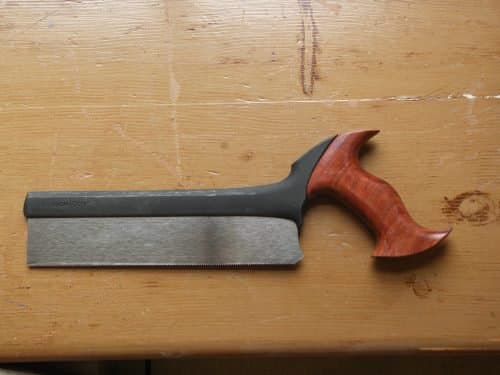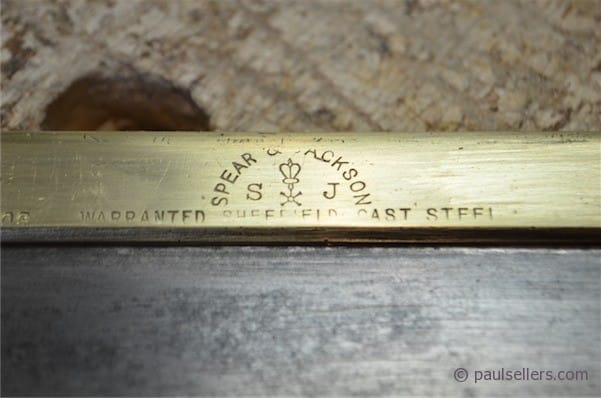Questions answered – Which handsaw for a beginner
Q:
Hi Paul:
I am brand new to woodworking and I’m trying to collect a good basic set of hand tools. I appreciated your blog entry about buying good inexpensive tools. It was very helpful. My question is what inexpensive hand saws would you recommend (for tenons, mitre cuts, rip cut, etc.)?
Thanks,
Dan
A:
Hello Dan,
This is a good question. I want to advise anyone starting out to buy a good, small saw that is already sharpened and has the exact amount of set so that they are not trying to work with a good, well made saw that’s old, dull and badly set. Eventually they must learn to sharpen, as even the best saws go dull within a few hours of use on hard and soft woods for a variety of different reasons.
Small tenon and dovetail saws

I know that the Veritas is not a particularly cheap saw to buy, but it is a lot less than most other saws and I think it comes to market at just about the best price out there and remember it does seem to me to be a lifetime saw. I have recently found more and more saws by what were once reputable makers that are junk, badly made or whatever so it has become increasingly more difficult to recommend a good saw.
Handsaw and not tenon or dovetail saws (Back saws USA)
Now, if you are talking handsaws, I have been regularly disappointed with even the high-end makers from time to time. Some think that quality components guarantee a good saw, but that is not always the case. Some plates have proven too thin and flex too much, wobble in the cut and even buckle when meeting even minimal resistance some times. Others have straight backs; That may be OK for a throwaway carpenter’s saw (I personally don’t think it is for that either) where the handle and back double as an on the job square, but when you understand how and why the refinements of a skew back came about, you better understand why they were so favoured by craftsmen, and then you wont settle for anything less. Another flawed view by some makers is that the plate doesn’t need to be taper ground. Again, flawed thinking by makers not users. On the job it makes a huge difference in the cut and so I look for these qualities in a saw.

If you are looking for a good bench hand saw such as a panel saw, which we use for rip and crosscut sawing, you cannot go wrong with a Disston D8 or similar. This will cost you anything between $20 and $70 in the USA and the same numbers in pound sterling in the UK. Spear and Jackson’s Superior 88 from the pre seventies will serve you well too, as will most of S&J’s pre 70’s handsaws. You can follow my saw sharpening video on YouTube here if you want to know how to sharpen them.
Best for now,
Paul
Paul


I think that Paul is giving some great advise here. I have been poking around ebay and I’ve bought some vintage saws. Some in great shape and some in not-so-great-shape. I don’t mind buying the junkers but even after a couple of years of buying saws, planes and chisels I can still get scammed on ebay.
I recently gave top dollar for a saw that I wanted from a seller that I thought was reputable. Come to find out, he has a scam going where another bidder runs up the price of his saws. Most won’t catch this tactic and I didn’t catch it until I was tipped off to it. It was too late, I had already bought the saw. Then I checked the person who bidded up on me and they have a long record of doing this for this particular seller.
I’ll keep the saw but my point is that even after buying more than a dozen ebay saws it can still happen to me.
So, buy the Veritas as Paul suggested and later chance the unknown of ebay, but don’t get soured right off the bat.
I now have a known saw guru who I can ask to check listings out for me before I bid. Kinda like having a mechanic look over a used truck before buying.
Yes, the best saw for a beginner is a sharp one. It’s the best saw for an experienced woodworker, too, come to think of it.
Paul/Joseph, what is recommended for beginner tenon saw, one of the Veritas? I have the dovetail but it does seem a little short in height. Can you recommend anything Veritas? Brass-backed Disston or S&J eBay grabs are easily as expensive and some are the Canadian resale “Warranted” junk I’ve read about.
Would the Lie Nielson dovetail saw be good for a beginner? It’s twice the price of the Veritas here in Australia but looks a very nice traditional design.
It is a very nice saw, but try to find a 16tpi if they make one, 20 tpi are harder to sharpen when you are not used to them and 16tpi is the perfect ratio of teeth for dovetail saws. None of my personal everyday saws are less than 16tpi.
Also, what is the advantage of the tapered dovetail saw over a straight one?
In my view, if any, none. For some reason people think saws were made that way and whereas some may have been, they mostly end up that way because we use the first half of the saw twice as much as the latter half.
Paul,
Thank you for the advice about the Disston D8.
If one is just getting started, would they need to get 2 panel saws – a crosscut and a rip saw; or can a single saw work for both?
Thank you,
Robert
A single saw always works for me. I always use a knifewall across the grain so I get good clean, pristine edges anyway I slice it.
Thank you, Paul.
What would that one saw be?
crosscut or rip, and what would be the TPI on it ?
Robert
Hi Paul,
Another informative blog post. You say;
‘Others have straight backs; That may be OK for a throwaway carpenter’s saw (I personally don’t think it is for that either) where the handle and back double as an on the job square, but when you understand how and why the refinements of a skew back came about, you better understand why they were so favoured by craftsmen, and then you wont settle for anything less’
Can you expand on this? (or is there another post which does?) Why is a straight back a bad thing?
Andrew
Hi Paul,
I really like the look of the saws you use and will most likely purchase one of your recommendations, but I am curious on your opinion of the Japanese handsaws.
Thanks,
Paul and his web site are the best thing that happened myself and my woodworking ever! Thank you, Paul
Tom
Paul,
I want your opinion on handsaws. I bought a Veritas carcass saw for cutting tenons, and for most cross cuts I use a Dewalt miter saw.
What saw would be the next priority for a hand saw? Would you suggest a rip saw, which I don’t have, or a general purpose saw, say 10 ppi that I can use for rip or cross cuts? I only have a Stanley 12 ppl saw, recently bought.
Also would like your opinion on whether to get a sharpened Henry Disston or a new Lynx?
Lastly, do you like the older spokeshaves? I also considered a new Kunz. eBay has gotten more expensive on tools, as many vendors are selling tuned tools, $130 for Disston saws, sometimes $150 to $200 for tuned and beautifully restored Stanley hand planes.
I just need a Stanley # 71 router and I will have all the joinery tools.
I have watched 4 of 7 videos of your Artisan DVDs, and learning a lot. I highly recommend them. Getting ready to do the table, mortise and tenon project. Would you consider selling me your templates for the legs and rails?
Paul,
I bought a nice Disston D8 10 ppi saw from Ebay that I plan to use for rip and cross cuts, until I can afford a rip saw. I was getting a bit frustrated and sometimes you see only expensive or saws in very bad shape. I still would like your opinion on a good rip saw, whether you would buy a new Lynx or a vintage Disston or other brand. I got my Veritas carcass saw today and like it, plan to try it out soon.
I was not finding the same mallet that you use, but did find a nice Halder 21 ounce mallet that I like very much. It is a high quality mallet. Just need the Stanley 71 router and a 4.5 Stanley plane and will be fixed up and ready to build the workbench. I am bidding on both now on Ebay.
Hi, Thanks for a very informative and inspiering blog. I am still a beginner woodworker so I have lots of questions ?
I have a question regarding ripping. What size hand saw would be reckomend for ripping the thicness of feks 2×8 or simular size oak. I am currently using a 7tpi 20’’ rip saw. Lots of work and not the best result